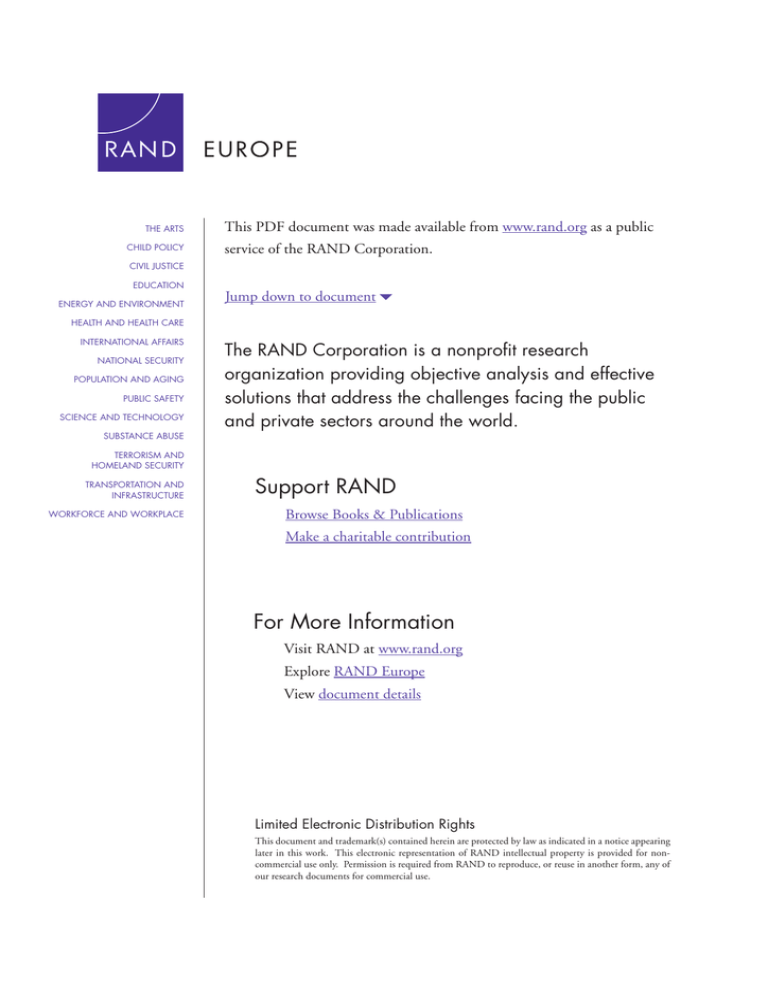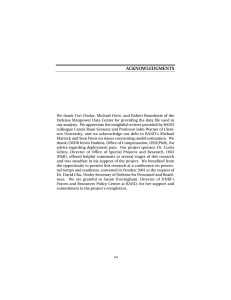
THE ARTS
CHILD POLICY
This PDF document was made available from www.rand.org as a public
service of the RAND Corporation.
CIVIL JUSTICE
EDUCATION
ENERGY AND ENVIRONMENT
Jump down to document6
HEALTH AND HEALTH CARE
INTERNATIONAL AFFAIRS
NATIONAL SECURITY
POPULATION AND AGING
PUBLIC SAFETY
SCIENCE AND TECHNOLOGY
SUBSTANCE ABUSE
The RAND Corporation is a nonprofit research
organization providing objective analysis and effective
solutions that address the challenges facing the public
and private sectors around the world.
TERRORISM AND
HOMELAND SECURITY
TRANSPORTATION AND
INFRASTRUCTURE
WORKFORCE AND WORKPLACE
Support RAND
Browse Books & Publications
Make a charitable contribution
For More Information
Visit RAND at www.rand.org
Explore RAND Europe
View document details
Limited Electronic Distribution Rights
This document and trademark(s) contained herein are protected by law as indicated in a notice appearing
later in this work. This electronic representation of RAND intellectual property is provided for noncommercial use only. Permission is required from RAND to reproduce, or reuse in another form, any of
our research documents for commercial use.
This product is part of the RAND Corporation technical report series. Reports may
include research findings on a specific topic that is limited in scope; present discussions of the methodology employed in research; provide literature reviews, survey
instruments, modeling exercises, guidelines for practitioners and research professionals, and supporting documentation; or deliver preliminary findings. All RAND
reports undergo rigorous peer review to ensure that they meet high standards for research quality and objectivity.
Interventions to reduce
anti-social behaviour and
crime
A review of effectiveness and costs
Jennifer Rubin, Lila Rabinovich, Michael Hallsworth,
Edward Nason
Prepared for the National Audit Office
The research described in this report was prepared for the National Audit Office.
The RAND Corporation is a nonprofit research organization providing objective analysis
and effective solutions that address the challenges facing the public and private sectors
around the world. RAND’s publications do not necessarily reflect the opinions of its
research clients and sponsors.
R® is a registered trademark.
© Copyright 2006 RAND Corporation
All rights reserved. No part of this book may be reproduced in any form by any electronic or
mechanical means (including photocopying, recording, or information storage and retrieval)
without permission in writing from RAND.
Published 2006 by the RAND Corporation
1776 Main Street, P.O. Box 2138, Santa Monica, CA 90407-2138
1200 South Hayes Street, Arlington, VA 22202-5050
4570 Fifth Avenue, Suite 600, Pittsburgh, PA 15213-2665
Westbrook Centre, Milton Road, Cambridge CB4 1YG, United Kingdom
RAND URL: http://www.rand.org/
RAND Europe URL: http://www.rand.org/randeurope
To order RAND documents or to obtain additional information, contact
Distribution Services: Telephone: (310) 451-7002;
Fax: (310) 451-6915; Email: order@rand.org
Executive Summary
Anti-social behaviour (ASB) is a costly and increasingly key topic of public concern in the
UK. In response to this problem, the UK Government is introducing new legal
instruments and policy initiatives to tackle ASB. These initiatives range from Anti-Social
Behaviour Orders to cognitive behavioural programmes and parenting skills training for atrisk families. Despite growing interest in these measures, there is a paucity of rigorous
evaluations of their effectiveness. Even more limited data exist on the cost-benefit
implications of programmes. This review focuses on available UK and US literature on the
effectiveness and cost-benefit analysis of interventions, and includes data from other
countries where available. The following are the key findings from this review.
There is an evaluation gap.
The relative absence of rigorous programme evaluations in Europe means that there is
insufficient data to allow robust analysis of the effectiveness of many interventions to
reduce anti-social behaviour. However, there are some interesting evaluation initiatives
currently underway in the Netherlands, such as the construction of cost-benefit models
and careful tracking of new programmes. The UK is also increasingly attempting to assess
and track the outcomes of interventions and programmes to reduce ASB and crime. This is
important because evaluation of interventions allows comparison of programmes, and thus
informed decision-making about the design and implementation of further programmes.
Early interventions can work, including those aimed at increasing participation in
education.
There are some parenting training and early childhood interventions (including prenatal
support) that have been rigorously evaluated and turn out to be some of the most effective
forms of intervention for reducing crime in target populations. The positive effects on
crime reduction found in evaluations of such programmes have been shown to persist
through to adulthood (Karoly et al, 2005). Educational incentives such as educational
maintenance allowances (EMAs) and graduation incentives may effectively reduce crime in
at-risk populations.
Preventing recidivism can work.
There is insufficient information gathered from evaluations and comparisons to draw firm
conclusions about the effectiveness of Anti-Social Behaviour Orders (ASBOs) and
Acceptable Behaviour Contracts (ABCs). However, there are more rigorously evaluated
interventions – such as multi-systemic therapy and cognitive behavioural programmes that have been shown to reduce recidivism. The data on the effectiveness of punitive
v
Interventions to reduce anti-social behaviour and crime
RAND Europe
measures is ambiguous at best, but many developmental or rehabilitative programmes
show positive results. These include cognitive behavioural programmes, interpersonal skills
training and counselling, and family-based interventions.
Restorative justice merits further evaluation.
Restorative justice interventions bring offenders into contact with the consequences of
their actions, in the form of meeting with the victims of crime or being made aware of the
extent of damage to property. Given the difficulties offenders may have with impulsecontrol and with taking account of the impact of their behaviour (Gottfredson and
Hirschi, 2000), it may prove effective to show individuals the harm they have caused, and,
as in some cases of restorative justice programmes, to require them to compensate for that
harm by repairing damage or by engaging in community service. Thus, restorative justice is
a form of intervention that merits further evaluation. Apart from possible benefits for
offenders, restorative justice programmes may be linked with improved outcomes for
victims by giving them a sense of control in the process, and may thereby reduce
psychological ramifications associated with being a victim of crime (New Zealand Youth
Justice).
Situational interventions can be an effective means of reducing offending.
Situational interventions are designed to reduce the opportunity to offend in a given
context. Implementing such interventions is an acknowledgement of the complex
confluence of factors determining the incidence of crime, including the offender’s
proclivity, the vulnerability of victims and the situational variables that make criminal
activity more likely or act as deterrents. Encouraging prosocial behaviour, for example by
keeping neighbourhoods clean and free of litter, and improving other features of the
context such as street lighting can effectively reduce the incidence of crime and ASB.
ASB and crime are expensive.
There are a range of direct costs, such as property damage, associated with ASB and crime.
These are relatively straightforward to quantify. There are also significant wider, indirect
costs to the community, to victims, to local businesses, etc. that are less readily
quantifiable. However, measures of direct and indirect costs of ASB and crime are high.
Aggregate data suggest that the cost of vandalism alone is in excess of one billion pounds
annually in the UK, and that the savings by diverting an individual from future
involvement in ASB and crime in the USA ranges from 1.7 to 2.3 million dollars. These
significant costs and potential savings highlight the importance of implementing and
evaluating interventions to prevent or reduce offending.
Cost-benefit matters when choosing between intervention options to optimise the
allocation of funds.
Cost-benefit ratios provide information about the unit of money saved, or the benefit, for a
given unit of money invested by implementing an intervention. This ratio provides a
useful ‘at-a-glance’ understanding of what may be the most efficient use of resources when
choosing between ASB and crime-reduction interventions. In order to make these
calculations data are needed about the differential effectiveness of programmes, the cost of
those programmes, and the benefits, or money saved, by reducing or preventing offending.
Comparing well evaluated, effective interventions, produces a range of cost-benefit ratios,
vi
RAND Europe
Executive Summary
with the lowest (in the meta-analyses covered in this report) providing a benefit of only
1.26 pounds for every pound spent and the highest providing a return of 17.07. However,
cost benefit is not the whole story. There may be benefits associated with certain ‘loweryield’ interventions that are more difficult to quantify or are in any case deemed worthy of
pursuing. For example, the cost-benefit ratio of 1.26 pertains to Nurse-Family Partnerships
lower-risk sample. Implementing the programme has a much lower yield with a lower-risk
sample than it does with a higher-risk sample. This may be due to the fact that in the
lower-risk sample fewer of the children would actually have gone on to become offenders.
While the higher-risk sample therefore has a higher cost-benefit ratio, policy makers may
nonetheless decide that it is worth intervening for the benefit of those few children who
would have gone on to become offenders. It is also possible that certain high-yield
programmes may be difficult or less desirable to implement, for example because of
political sensitivity or high start-up costs.
vii






